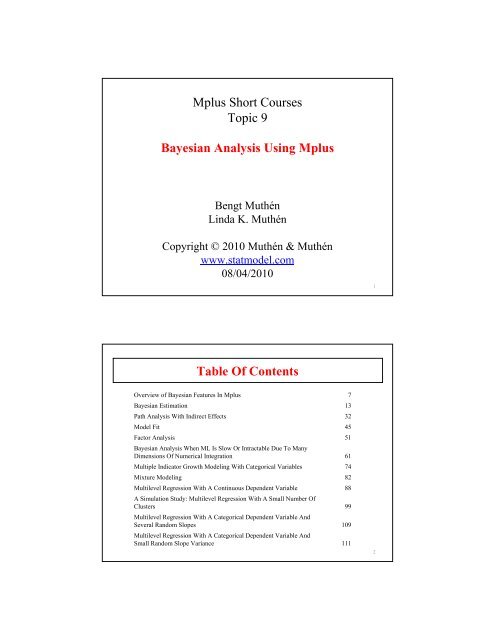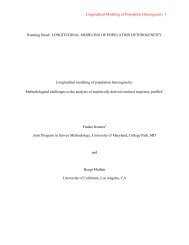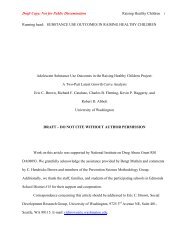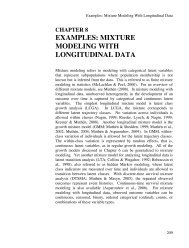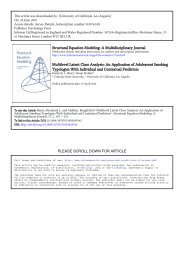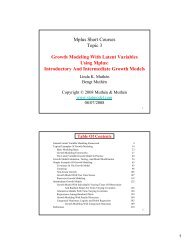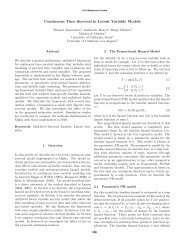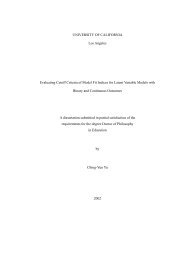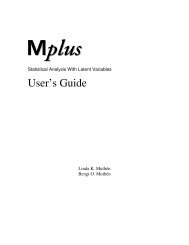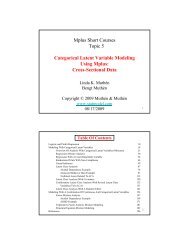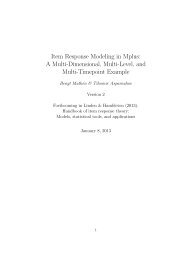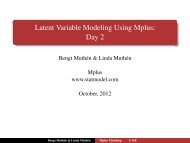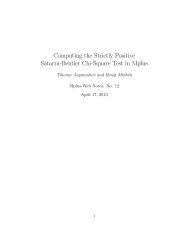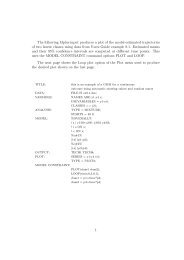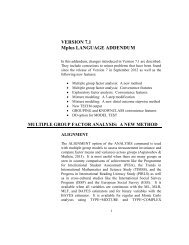handout - Mplus
handout - Mplus
handout - Mplus
Create successful ePaper yourself
Turn your PDF publications into a flip-book with our unique Google optimized e-Paper software.
<strong>Mplus</strong> Short Courses<br />
Topic 9<br />
Bayesian Analysis Using <strong>Mplus</strong><br />
Bengt Muthén<br />
Linda K. Muthén<br />
Copyright © 2010 Muthén & Muthén<br />
www.statmodel.com<br />
08/04/2010<br />
1<br />
Table Of Contents<br />
Overview of Bayesian Features In <strong>Mplus</strong> 7<br />
Bayesian Estimation 13<br />
Path Analysis With Indirect Effects 32<br />
Model Fit 45<br />
Factor Analysis 51<br />
Bayesian Analysis When ML Is Slow Or Intractable Due To Many<br />
Dimensions Of Numerical Integration 61<br />
Multiple Indicator Growth Modeling With Categorical Variables 74<br />
Mixture Modeling 82<br />
Multilevel Regression With A Continuous Dependent Variable 88<br />
A Simulation Study: Multilevel Regression With A Small Number Of<br />
Clusters 99<br />
Multilevel Regression With A Categorical Dependent Variable And<br />
Several Random Slopes 109<br />
Multilevel Regression With A Categorical Dependent Variable And<br />
Small Random Slope Variance 111<br />
2
Table Of Contents (Continued)<br />
Multiple Imputation 115<br />
Multiple Imputation With A Categorical Outcome In A Growth<br />
Model With MAR Missing Data: Using WLSMV On Imputed Data 126<br />
H 0 Imputation 129<br />
Two-Level Imputation 133<br />
Chi-Square Model Testing Using Multiple Imputation Data:<br />
Asparouhov-Muthén (2010): Chi-Square Statistics With Multiple<br />
Imputation 141<br />
Overview Of Other New Features In <strong>Mplus</strong> Version 6 146<br />
References 153<br />
3<br />
<strong>Mplus</strong> conceptualization:<br />
Bayesian Analysis In <strong>Mplus</strong><br />
• <strong>Mplus</strong> was envisioned 15 years ago as both a frequentist and a<br />
Bayesian program<br />
• Bayesian analysis firmly established and its use growing in<br />
mainstream statistics<br />
• Much less use of Bayes outside statistics<br />
• Bayesian analysis not sufficiently accessible in other programs<br />
• Bayes provides a broader platform for further <strong>Mplus</strong><br />
development<br />
4
Bayesian Analysis<br />
Why do we have to learn about Bayes<br />
• More can be learned about parameter estimates and model fit<br />
• Better small-sample performance, large-sample theory not<br />
needed<br />
• Analyses can be made less computationally demanding<br />
• New types of models can be analyzed<br />
5<br />
Writings On<br />
The Bayes Implementation In <strong>Mplus</strong><br />
• Asparouhov & Muthén (2010a). Bayesian analysis using<br />
<strong>Mplus</strong>. Technical appendix<br />
• Asparouhov & Muthén, B. (2010b). Bayesian analysis of<br />
latent variable models using <strong>Mplus</strong>. <strong>Mplus</strong> scripts and data.<br />
• Asparouhov, T. & Muthén, B. (2010c). Multiple imputation<br />
with <strong>Mplus</strong>. <strong>Mplus</strong> scripts and data.<br />
• Muthén (2010). Bayesian analysis in <strong>Mplus</strong>: A brief<br />
introduction. Technical report with <strong>Mplus</strong> scripts and data.<br />
Ongoing writing - comments invited<br />
Posted under Papers, Bayesian Analysis<br />
6
Overview Of Bayesian Features In <strong>Mplus</strong><br />
7<br />
Bayesian Estimation In <strong>Mplus</strong><br />
• Single-level, multilevel, and mixture models<br />
• Continuous and categorical outcomes (probit link)<br />
• Default non-informative priors or user-specified informative<br />
priors (MODEL PRIORS)<br />
• Multiple chains using parallel processing (CHAIN)<br />
• Convergence assessment using Gelman-Rubin potential scale<br />
reduction factors<br />
• Posterior parameter distributions with means, medians, modes,<br />
and credibility intervals (POINT)<br />
• Posterior parameter trace plots<br />
• Autocorrelation plots<br />
• Posterior predictive checking plots<br />
8
Multiple Imputation (DATA IMPUTATION)<br />
• Carried out using Bayesian estimation to create several data<br />
sets where missing values have been imputed<br />
• The multiple imputation data sets can be used for subsequent<br />
model estimation using ML or WLSMV<br />
• The imputed data sets can be saved for subsequent analysis or<br />
analysis can be carried out in the same run<br />
• Imputation can be done based on an unrestricted H1 model<br />
using three different algorithms including sequential<br />
regressions<br />
• Imputation can also be done based on an H0 model specified<br />
in the MODEL command<br />
9<br />
Multiple Imputation (Continued)<br />
• The set of variables used in the imputation of the data do not<br />
need to be the same as the set of variables used in the analysis<br />
• Single-level and multilevel data imputation are available<br />
• Multiple imputation data can be read using<br />
TYPE=IMPUTATION in the DATA command<br />
10
Plausible Values (PLAUSIBLE)<br />
• Plausible values used in IRT contexts such as the ETS NAEP,<br />
The Nation’s Report Card (Mislevy et al., 1992)<br />
• Plausible values are multiple imputations for missing values<br />
corresponding to a latent variable<br />
• Available for both continuous and categorical latent variables<br />
(factors, random effects, latent classes)<br />
• More informative than only an estimated factor score and its<br />
standard error or a class probability<br />
• Plausible values are given for each observation together with a<br />
summary over the imputed data sets for each observation and<br />
latent variable<br />
• Multiple imputation and plausible values examples are given<br />
in the User’s Guide, Chapter 11<br />
11<br />
Bayesian Analysis Using <strong>Mplus</strong>:<br />
An Ongoing Project<br />
Features that are not yet implemented include:<br />
• EFA and ESEM<br />
• Logit link<br />
• Censored, count, and nominal variables<br />
• XWITH<br />
• Weights<br />
• Random slopes in single-level models<br />
• Latent variable decomposition of covariates in two-level models<br />
• c ON x in mixtures<br />
• Mixture models with more than one categorical latent variable<br />
• Two-level mixtures<br />
• MODEL INDIRECT<br />
• MODEL CONSTRAINT except for NEW parameters<br />
• MODEL TEST 12
Bayesian Estimation<br />
13<br />
Prior, Likelihood, And Posterior<br />
• Frequentist view: Parameters are fixed. ML estimates have an<br />
asymptotically-normal distribution<br />
• Bayesian view: Parameters are variables that have a prior<br />
distribution. Estimates have a possibly non-normal posterior<br />
distribution. Does not depend on large-sample theory<br />
– Diffuse (non-informative) priors vs informative priors<br />
Posterior<br />
Prior<br />
Likelihood<br />
14
Bayes Theorem<br />
• Probabilities of events A and B:<br />
Bayes theorem:<br />
• Applied to modeling:<br />
• Posterior<br />
15<br />
Where Do Parameter Priors Come From<br />
• Previous studies<br />
• Hypotheses based on substantive theory<br />
– Example: Zero cross-loadings in CFA<br />
Prior<br />
λ ~ N(0,0.01)<br />
-0.2<br />
0 +0.2<br />
95%<br />
16
Non-Normal Posterior<br />
Parameter Distribution<br />
Density Function<br />
3.4<br />
3.2<br />
3<br />
2.8<br />
2.6<br />
2.4<br />
2.2<br />
2<br />
1.8<br />
1.6<br />
1.4<br />
1.2<br />
1<br />
0.8<br />
0.6<br />
0.4<br />
0.2<br />
Mean = -0.20793<br />
Median = -0.18290<br />
Mode = -0.14376<br />
95% Lower CI = -0.53075<br />
95% Upper CI = 0.02579<br />
0<br />
-1<br />
-0.95<br />
-0.9<br />
-0.85<br />
-0.8<br />
-0.75<br />
-0.7<br />
-0.65<br />
-0.6<br />
-0.55<br />
-0.5<br />
-0.45<br />
-0.4<br />
-0.35<br />
-0.3<br />
-0.25<br />
Estimate<br />
-0.2<br />
-0.15<br />
-0.1<br />
-0.05<br />
0<br />
0.05<br />
0.1<br />
0.15<br />
0.2<br />
0.25<br />
0.3<br />
0.35<br />
0.4<br />
17<br />
Bayesian Estimation Using the Markov Chain<br />
Monte Carlo (MCMC) Algorithm<br />
• θ i : vector of parameters, latent variables, and missing<br />
observations at iteration i<br />
• θ i is divided into S sets:<br />
θ i = (θ 1i , …, θ Si )<br />
• Update θ using Gibbs sampling over i = 1, 2, …, n iterations:<br />
θ 1i | θ 2i-1 ,…, θ Si-1 , data, priors<br />
θ 2i | θ 1i , θ 3i-1 ,…, θ Si-1 , data, priors<br />
…<br />
θ Si | θ 1i , …, θ S-1i-1 , data, priors<br />
Asparouhov & Muthén (2010a). Bayesian analysis using <strong>Mplus</strong>.<br />
Technical appendix. 18
MCMC Iteration Issues<br />
• Trace plot: Graph of the value of a parameter at different<br />
iterations<br />
• Burnin phase: Discarding early iterations. <strong>Mplus</strong> discards<br />
first half<br />
• Posterior distribution: <strong>Mplus</strong> uses the last half as a sample<br />
representing the posterior distribution<br />
• Autocorrelation plot: Correlation between different iterations<br />
for a parameter. Low correlation desired<br />
• Mixing: The MCMC chain should visit the full range of<br />
parameter values, i.e. sample from all areas of the posterior<br />
density<br />
• Convergence: Stationary process.<br />
19<br />
Bayes Graphs<br />
20
Trace Plot 1<br />
0<br />
5<br />
10<br />
15<br />
20<br />
25<br />
30<br />
35<br />
40<br />
45<br />
50<br />
55<br />
60<br />
65<br />
70<br />
75<br />
80<br />
85<br />
90<br />
95<br />
100<br />
105<br />
0.8<br />
0.85<br />
0.9<br />
0.95<br />
1<br />
1.05<br />
1.1<br />
1.15<br />
1.2<br />
1.25<br />
1.3<br />
1.35<br />
1.4<br />
1.45<br />
1.5<br />
1.55<br />
1.6<br />
1.65<br />
1.7<br />
1.75<br />
1.8<br />
1.85<br />
1.9<br />
1.95<br />
2<br />
21<br />
Auto Correlation Plot 1<br />
1<br />
2<br />
3<br />
4<br />
5<br />
6<br />
7<br />
8<br />
9<br />
10<br />
11<br />
12<br />
13<br />
14<br />
15<br />
16<br />
17<br />
18<br />
19<br />
20<br />
21<br />
22<br />
23<br />
24<br />
25<br />
26<br />
27<br />
28<br />
29<br />
30<br />
-1<br />
-0.9<br />
-0.8<br />
-0.7<br />
-0.6<br />
-0.5<br />
-0.4<br />
-0.3<br />
-0.2<br />
-0.1<br />
0<br />
0.1<br />
0.2<br />
0.3<br />
0.4<br />
0.5<br />
0.6<br />
0.7<br />
0.8<br />
0.9<br />
1<br />
22
Trace Plot 2<br />
0<br />
50<br />
100<br />
150<br />
200<br />
250<br />
300<br />
350<br />
400<br />
450<br />
500<br />
550<br />
600<br />
650<br />
700<br />
750<br />
800<br />
850<br />
900<br />
950<br />
1000<br />
1050<br />
1100<br />
1150<br />
1200<br />
1250<br />
1300<br />
1350<br />
1400<br />
1450<br />
1500<br />
1550<br />
1600<br />
1650<br />
1700<br />
1750<br />
1800<br />
1850<br />
1900<br />
1950<br />
2000<br />
2050<br />
2100<br />
-0.02<br />
-0.015<br />
-0.01<br />
-0.005<br />
0<br />
0.005<br />
0.01<br />
0.015<br />
0.02<br />
0.025<br />
0.03<br />
0.035<br />
0.04<br />
0.045<br />
0.05<br />
0.055<br />
0.06<br />
0.065<br />
0.07<br />
0.075<br />
0.08<br />
0.085<br />
0.09<br />
23<br />
Auto Correlation Plot 2<br />
1<br />
2<br />
3<br />
4<br />
5<br />
6<br />
7<br />
8<br />
9<br />
10<br />
11<br />
12<br />
13<br />
14<br />
15<br />
16<br />
17<br />
18<br />
19<br />
20<br />
21<br />
22<br />
23<br />
24<br />
25<br />
26<br />
27<br />
28<br />
29<br />
30<br />
-1<br />
-0.9<br />
-0.8<br />
-0.7<br />
-0.6<br />
-0.5<br />
-0.4<br />
-0.3<br />
-0.2<br />
-0.1<br />
0<br />
0.1<br />
0.2<br />
0.3<br />
0.4<br />
0.5<br />
0.6<br />
0.7<br />
0.8<br />
0.9<br />
1<br />
24
Trace Plot 3<br />
0<br />
500<br />
1000<br />
1500<br />
2000<br />
2500<br />
3000<br />
3500<br />
4000<br />
4500<br />
5000<br />
5500<br />
6000<br />
6500<br />
7000<br />
7500<br />
8000<br />
8500<br />
9000<br />
9500<br />
10000<br />
10500<br />
11000<br />
11500<br />
12000<br />
12500<br />
13000<br />
13500<br />
14000<br />
14500<br />
15000<br />
15500<br />
16000<br />
16500<br />
17000<br />
17500<br />
18000<br />
18500<br />
19000<br />
19500<br />
20000<br />
20500<br />
21000<br />
21500<br />
22000<br />
22500<br />
-1.8<br />
-1.7<br />
-1.6<br />
-1.5<br />
-1.4<br />
-1.3<br />
-1.2<br />
-1.1<br />
-1<br />
-0.9<br />
-0.8<br />
-0.7<br />
-0.6<br />
-0.5<br />
-0.4<br />
-0.3<br />
-0.2<br />
-0.1<br />
0<br />
0.1<br />
0.2<br />
0.3<br />
0.4<br />
0.5<br />
0.6<br />
25<br />
Auto Correlation Plot 3<br />
1<br />
2<br />
3<br />
4<br />
5<br />
6<br />
7<br />
8<br />
9<br />
10<br />
11<br />
12<br />
13<br />
14<br />
15<br />
16<br />
17<br />
18<br />
19<br />
20<br />
21<br />
22<br />
23<br />
24<br />
25<br />
26<br />
27<br />
28<br />
29<br />
30<br />
-1<br />
-0.9<br />
-0.8<br />
-0.7<br />
-0.6<br />
-0.5<br />
-0.4<br />
-0.3<br />
-0.2<br />
-0.1<br />
0<br />
0.1<br />
0.2<br />
0.3<br />
0.4<br />
0.5<br />
0.6<br />
0.7<br />
0.8<br />
0.9<br />
1<br />
26
Posterior Using Histogram Option<br />
750<br />
700<br />
650<br />
600<br />
550<br />
500<br />
450<br />
Mean = -0.20793<br />
Median = -0.18290<br />
Mode = -0.14376<br />
95% Lower CI = -0.53075<br />
95% Upper CI = 0.02579<br />
400<br />
350<br />
300<br />
250<br />
200<br />
150<br />
100<br />
50<br />
0<br />
-0.9<br />
-0.85<br />
-0.8<br />
-0.75<br />
-0.7<br />
-0.65<br />
-0.6<br />
-0.55<br />
-0.5<br />
-0.45<br />
-0.4<br />
-0.35<br />
-0.3<br />
-0.25<br />
-0.2<br />
-0.15<br />
-0.1<br />
Count<br />
-0.05<br />
0<br />
0.05<br />
0.1<br />
0.15<br />
0.2<br />
0.25<br />
Estimate<br />
27<br />
Posterior Using Kernel Option<br />
Density Function<br />
3.4<br />
3.2<br />
3<br />
2.8<br />
2.6<br />
2.4<br />
2.2<br />
2<br />
1.8<br />
1.6<br />
1.4<br />
1.2<br />
1<br />
0.8<br />
0.6<br />
0.4<br />
0.2<br />
0<br />
-1<br />
-0.95<br />
-0.9<br />
-0.85<br />
-0.8<br />
-0.75<br />
-0.7<br />
-0.65<br />
-0.6<br />
-0.55<br />
-0.5<br />
-0.45<br />
-0.4<br />
-0.35<br />
-0.3<br />
-0.25<br />
-0.2<br />
-0.15<br />
-0.1<br />
-0.05<br />
0<br />
0.05<br />
0.1<br />
0.15<br />
0.2<br />
0.25<br />
0.3<br />
0.35<br />
0.4<br />
Mean = -0.20793<br />
Median = -0.18290<br />
Mode = -0.14376<br />
95% Lower CI = -0.53075<br />
95% Upper CI = 0.02579<br />
Estimate<br />
28
Convergence: Potential Scale Reduction Factor<br />
(PSR; TECH8)<br />
• Several MCMC iterations carried out in parallel, independent chains. PSR<br />
considers n iterations in m chains, where θ ij is the value of θ in iteration i of<br />
chain j:<br />
• Convergence if PSR is not much larger than 1, e.g. less than 1.05 or 1.1.<br />
29<br />
TECH8 For Bayes<br />
30
Options Related To Bayes Estimation<br />
And Multiple Imputation<br />
See User’s Guide pages 559-563:<br />
• POINT (mean, median, mode; default is median)<br />
• CHAINS (default is 2)<br />
• BSEED<br />
• STVALUES (= ML)<br />
• MEDIATOR (observed, latent; default is latent)<br />
• ALGORITHM (GIBBS, MH; default is GIBBS)<br />
• BCONVERGENCE (related to PSR)<br />
• BITERATIONS (to go beyond 50K iterations)<br />
• FBITERATIONS (fixed number of iterations)<br />
• THIN (every kth iteration recorded; default is 1)<br />
• DISTRIBUTION (how many iterations used for MODE)<br />
31<br />
Path Analysis With Indirect Effects<br />
32
Mediation Modeling With Diffuse Priors:<br />
ATLAS Example<br />
Source: MacKinnon et al. (2004), MBR. n = 861<br />
a<br />
severity<br />
b<br />
group<br />
c<br />
nutrition<br />
• Intervention aimed at increasing perceived severity of using<br />
steroids among athletes. Perceived severity of using steroids is<br />
in turn hypothesized to increase good nutrition behaviors<br />
• Indirect effect: a x b<br />
33<br />
Input For Bayesian Analysis<br />
Of ATLAS Example<br />
TITLE: ATLAS<br />
DATA:<br />
FILE = mbr2004atlast.txt;<br />
VARIABLE: NAMES = obs group severity nutrit;<br />
USEV = group – nutrit;<br />
ANALYSIS: ESTIMATOR = BAYES;<br />
PROCESS = 2;<br />
MODEL: severity ON group (a);<br />
nutrit ON severity (b)<br />
group;<br />
MODEL CONSTRAINT:<br />
NEW (indirect);<br />
indirect = a*b;<br />
OUTPUT: TECH1 TECH8 STANDARDIZED;<br />
PLOT:<br />
TYPE = PLOT2;<br />
34
Output For Bayesian Analysis<br />
Of ATLAS Example<br />
Posterior One-Tailed 95% C.I.<br />
Parameter Estimate S.D. P-Value Lower 2.5% Upper 2.5%<br />
severity ON<br />
group 0.282 0.106 0.010 0.095 0.486<br />
nutrit ON<br />
severity 0.067 0.031 0.000 0.015 0.125<br />
group -0.011 0.089 0.440 -0.180 0.155<br />
Intercepts<br />
severity 5.641 0.072 0.000 5.513 5.779<br />
nutrit 3.698 0.191 0.000 3.309 4.018<br />
35<br />
Output For Bayesian Analysis<br />
Of ATLAS Example (Continued)<br />
Posterior One-Tailed 95% C.I.<br />
Parameter Estimate S.D. P-Value Lower 2.5% Upper 2.5%<br />
Residual variances<br />
severity 1.722 0.072 0.000 1.614 1.868<br />
group 1.331 0.070 0.000 1.198 1.468<br />
New/Additional parameters<br />
indirect 0.016 0.013 0.010 0.002 0.052<br />
36
Output For Bayesian Analysis<br />
Of ATLAS Example (Continued)<br />
TECHNICAL 8 OUTPUT FOR BAYES ESTIMATION<br />
CHAIN BSEED<br />
1 0<br />
2 285380<br />
POTENTIAL PARAMETER WITH<br />
ITERATION SCALE REDUCTION HIGHEST PSR<br />
100 1.037 2<br />
37<br />
Posterior Distribution For<br />
Indirect Effect: 100 Iterations<br />
7<br />
6.5<br />
6<br />
5.5<br />
5<br />
4.5<br />
Mean = 0.01916<br />
Median = 0.01643<br />
Mode = 0.01115<br />
95% Lower CI = 0.00209<br />
95% Upper CI = 0.05186<br />
4<br />
3.5<br />
3<br />
2.5<br />
2<br />
1.5<br />
1<br />
0.5<br />
0<br />
-0.0035<br />
-0.0015<br />
0.0005<br />
0.0025<br />
0.0045<br />
0.0065<br />
0.0085<br />
0.0105<br />
0.0125<br />
0.0145<br />
0.0165<br />
0.0185<br />
0.0205<br />
0.0225<br />
0.0245<br />
0.0265<br />
0.0285<br />
0.0305<br />
0.0325<br />
0.0345<br />
0.0365<br />
0.0385<br />
0.0405<br />
0.0425<br />
0.0445<br />
0.0465<br />
0.0485<br />
0.0505<br />
0.0525<br />
0.0545<br />
0.0565<br />
Count<br />
0.0585<br />
0.0605<br />
0.0625<br />
0.0645<br />
Estimate<br />
38
<strong>Mplus</strong> Input For Bayesian Analysis<br />
Of ATLAS Example (Continued)<br />
ANALYSIS:<br />
ESTIMATOR = BAYES;<br />
PROCESS = 2;<br />
FBITER = 10000;<br />
39<br />
Bayesian Posterior Distribution<br />
For The Indirect Effect: 10000 Iterations<br />
Count<br />
500<br />
480<br />
460<br />
440<br />
420<br />
400<br />
380<br />
360<br />
340<br />
320<br />
300<br />
280<br />
260<br />
240<br />
220<br />
200<br />
180<br />
160<br />
140<br />
120<br />
100<br />
80<br />
60<br />
40<br />
20<br />
0<br />
-0.02<br />
-0.015<br />
-0.01<br />
-0.005<br />
0<br />
Mean = 0.02026<br />
Median = 0.01883<br />
Mode = 0.01860<br />
95% Lower CI = 0.00274<br />
95% Upper CI = 0.04486<br />
0.005<br />
0.01<br />
0.015<br />
0.02<br />
0.025<br />
0.03<br />
0.035<br />
0.04<br />
0.045<br />
0.05<br />
0.055<br />
0.06<br />
0.065<br />
0.07<br />
0.075<br />
0.08<br />
0.085<br />
0.09<br />
Estimate<br />
40
Bayesian Posterior Distribution<br />
For The Indirect Effect<br />
• Bayesian analysis: There is a mediated effect of the<br />
intervention<br />
– The 95% Bayesian credibility interval does not include zero<br />
• ML analysis: There is not a mediated effect of the intervention<br />
– ML-estimated indirect effect is not significantly different<br />
from zero and the symmetric confidence interval includes<br />
zero<br />
– Bootstrap SEs and CIs can be used with ML<br />
41<br />
Mediation Modeling With Informative Priors:<br />
Firefighter Example. N = 354<br />
• Source: Yuan & MacKinnon (2009). Bayesian Mediation<br />
Analysis. Psychological Methods, 14, 301-322.<br />
– Nice description of Bayesian analysis<br />
• Informative priors based on previous studies: a~N (0.35, 0.04),<br />
b~N (0.1, 0.01)<br />
• 95% credibility interval for indirect effect shrunken by 16%<br />
• WinBUGS code in Yuan & MacKinnon (2009).<br />
<strong>Mplus</strong> code on next slide using MODEL PRIORS. Same<br />
results<br />
42
<strong>Mplus</strong> Input For Bayesian Analysis<br />
With Priors: Firefighters<br />
TITLE: Yuan and MacKinnon firefighters mediation using<br />
Bayesian analysis<br />
Elliot DL., Goldberg L., Kuehl KS, et al. The PHLAME<br />
Study: process and outcomes of 2 models of behavior<br />
change. J Occup Environ Med. 2007; 49(2): 204-213.<br />
DATA: FILE = fire.dat;<br />
VARIABLE: NAMES = y m x;<br />
MODEL: m ON x (a);<br />
y ON m (b)<br />
x;<br />
ANALYSIS: ESTIMATOR = BAYES;<br />
PROCESS = 2;<br />
FBITER = 10000;<br />
43<br />
<strong>Mplus</strong> Input For Bayesian Analysis<br />
With Priors: Firefighters (Continued)<br />
MODEL PRIORS:<br />
a ~ N(0.35, 0.04);<br />
b ~ N(0.1, 0.01);<br />
MODEL CONSTRAINT:<br />
NEW (indirect);<br />
indirect = a*b;<br />
OUTPUT: TECH1 TECH8;<br />
PLOT: TYPE = PLOT2;<br />
44
Model Fit<br />
45<br />
Posterior Predictive Checking<br />
• A posterior predictive p-value (PPP) of model fit can be<br />
obtained via a fit statistic f based on the usual chi-square test<br />
of H 0 against H 1 . Low PPP indicates poor fit<br />
• Let f(Y, X, θ i ) be computed for the data Y, X using the<br />
parameter values at iteration i<br />
• At iteration i, generate a new data set Y i * (synthetic/replicated<br />
data) of the same size as the original data using the parameter<br />
values at iteration i and compute f(Y i *, X, θ i ) for these<br />
replicated data<br />
46
Posterior Predictive Checking (Continued)<br />
• PPP is approximated by the proportion of iterations where<br />
f(Y, X, θ i ) < f(Y i *, X, θ i )<br />
• <strong>Mplus</strong> computes PPP using every 10 th iteration among the<br />
iterations used to describe the posterior distribution of<br />
parameters<br />
• A 95% confidence interval is produced for the difference in<br />
chi-square for the real and replicated data; negative lower limit<br />
is good<br />
47<br />
Posterior Predictive Checking For<br />
A Poorly Fitting Model<br />
48
Posterior Predictive Checking For<br />
A Well Fitting Model<br />
PPC distribution for Bayes CFA<br />
PPC scatterplot for Bayes CFA<br />
49<br />
Deviance Information Criterion (DIC)<br />
• DIC is a Bayesian generalization of the ML AIC and BIC (low<br />
value is good)<br />
• DIC uses a number of parameters the effective number of<br />
parameters referred to as p D<br />
50
Factor Analysis<br />
51<br />
Holzinger-Swineford Data<br />
• 19 tests hypothesized to measure four mental abilities: Spatial,<br />
verbal, speed, and memory<br />
• n=145 7 th and 8 th grade students from Grant-White elementary<br />
school<br />
Source: Muthén (2010). Bayesian analysis in <strong>Mplus</strong>: A brief<br />
introduction. Technical report with <strong>Mplus</strong> scripts and data.<br />
52
Factor loading pattern<br />
spatial<br />
verbal<br />
speed<br />
memory<br />
visual<br />
cubes<br />
paper<br />
flags<br />
general<br />
paragrap<br />
sentence<br />
wordc<br />
wordm<br />
addition<br />
code<br />
counting<br />
straight<br />
wordr<br />
numberr<br />
figurer<br />
object<br />
numberf<br />
figurew<br />
Spatial Verbal Speed Memory<br />
visual x 0 0 0<br />
cubes x 0 0 0<br />
paper x 0 0 0<br />
flags x 0 0 0<br />
general 0 x 0 0<br />
paragrap 0 x 0 0<br />
sentence 0 x 0 0<br />
wordc 0 x 0 0<br />
wordm 0 x 0 0<br />
addition 0 0 x 0<br />
code 0 0 x 0<br />
counting 0 0 x 0<br />
straight 0 0 x 0<br />
wordr 0 0 0 x<br />
numberr 0 0 0 x<br />
figurer 0 0 0 x<br />
object 0 0 0 x<br />
numberf 0 0 0 x<br />
figurew 0 0 0 x<br />
53<br />
ML Tests Of Model Fit For<br />
Holzinger-Swineford (N = 145)<br />
• Confirmatory factor analysis (CFA) model rejected:<br />
– ML likelihood-ratio chi-square p = 0.0002<br />
(CFI = 0.93, RMSEA = 0.057, SRMR = 0.063)<br />
• Modification indices point to three cross-loadings<br />
(Modindices by Sörbom, 1989)<br />
• Model still rejected when those are freed<br />
• Exploratory factor analysis (EFA) with 4 factors using oblique<br />
rotation (Geomin):<br />
– ML likelihood-ratio chi-square p = 0.248<br />
(CFI = 0.99, RMSEA = 0.025, SRMR = 0.030)<br />
• The pattern of major loadings is as hypothesized<br />
• Several significant cross-loadings<br />
54
Bayesian CFA Using MCMC For<br />
Holzinger-Swineford<br />
• CFA: Cross-loadings fixed at zero - the model is rejected<br />
• A more realistic hypothesis: Small cross-loadings allowed<br />
• Cross-loadings are not all identified in terms of ML<br />
• Different alternative: Bayesian CFA with informative crossloading<br />
priors: λ ~ N(0, 0.01).<br />
This means that 95% of the prior is in the range -0.2 to 0.2<br />
55<br />
Bayesian Posterior Predictive Checking<br />
For The CFA Model<br />
CFA with small cross-loadings<br />
not rejected by Bayes PPC:<br />
p = 0.353<br />
Conventional CFA model<br />
rejected by Bayes PPC:<br />
p = 0.006:<br />
56
Summary Of Analyses Of<br />
Holzinger-Swineford Data<br />
• Conventional, frequentist, CFA model rejected<br />
• Bayesian CFA not rejected with cross-loadings<br />
• The Bayesian approach uses an intermediate hypothesis:<br />
– Less strict than conventional CFA<br />
– Stricter than EFA, where the hypothesis only concerns the<br />
number of factors<br />
• Bayes modification indices obtained by estimated crossloadings<br />
57<br />
Input Bayes CFA 19 Items 4 Factors<br />
Crossloading Priors<br />
DEFINE:<br />
visual = visual/sqrt(47.471);<br />
cubes = cubes /sqrt(19.622);<br />
paper = paper /sqrt(7.908);<br />
flags = flags/sqrt(68.695);<br />
general = general/sqrt(134.970);<br />
paragrap = paragrap/sqrt(11.315);<br />
sentence = sentence/sqrt(21.467);<br />
wordc = wordc/sqrt(28.505);<br />
wordm = wordm/sqrt(62.727);<br />
addition = addition/sqrt(561.692);<br />
code = code/sqrt(275.759);<br />
counting = counting/sqrt(437.752);<br />
straight = straight/sqrt(1362.158);<br />
wordr = wordr/sqrt(116.448);<br />
numberr = numberr/sqrt(56.496);<br />
figurer = figurer/sqrt(45.937);<br />
object = object/sqrt(20.730);<br />
numberf = numberf/sqrt(20.150);<br />
figurew = figurew/sqrt(12.845);<br />
58
Input Bayes CFA 19 Items 4 Factors<br />
Crossloading Priors (Continued)<br />
ANALYSIS:<br />
MODEL:<br />
ESTIMATOR = BAYES;<br />
PROCESS = 2;<br />
FBITER = 10000;<br />
spatial BY visual* cubes paper flags;<br />
verbal BY general* paragrap sentence wordc wordm;<br />
speed BY addition* code counting straight;<br />
memory BY wordr* numberr figurer object numberf<br />
figurew;<br />
spatial-memory@1;<br />
spatial BY general-figurew*0 (a1-a15);<br />
verbal BY visual-flags*0 (b1-b4);<br />
verbal BY addition-figurew*0 (b5-b14);<br />
speed BY visual-wordm*0 (c1-c9);<br />
speed BY wordr-figurew*0 (c10-c15);<br />
memory BY visual-straight*0 (d1-d13);<br />
59<br />
Input Bayes CFA 19 Items 4 Factors<br />
Crossloading Priors (Continued)<br />
MODEL PRIORS:<br />
a1-a15 ~ N(0,.01);<br />
b1-b14 ~ N(0,.01);<br />
c1-c15 ~ N(0,.01);<br />
d1-d13 ~ N(0,.01);<br />
OUTPUT: TECH1 TECH8 STDYX;<br />
PLOT: TYPE = PLOT2;<br />
60
Bayesian Analysis When ML Is Slow Or<br />
Intractable Due To Many Dimensions Of<br />
Numerical Integration<br />
61<br />
Structural Equation Model With<br />
Categorical Factor Indicators Of<br />
Three Factors At Two Timepoints<br />
62
Johns Hopkins Aggression Study,<br />
13 Items, Cohort 3 (N=678)<br />
Factor loadings<br />
Grade 1 Grade 3<br />
Variables Verbal Person Property Verbal Person Property<br />
stubborn 0.892* 0.000 -0.286* 0.913* 0.000 -0.220*<br />
breaks rules 0.413* 0.301* 0.001 0.500* 0.286* 0.001<br />
harms others & property -0.007 0.508* 0.376* -0.009 0.526* 0.372*<br />
breaks things 0.016 0.006 0.808* 0.017 0.057 0.669*<br />
yells at others 0.803* 0.019 -0.053 0.821* 0.015 -0.040<br />
takes others’ property 0.227 0.026 0.589* 0.277 0.025 0.541*<br />
fights 0.016 0.886* 0.074 0.020 0.838* 0.067<br />
harms property 0.155 0.004 0.819* 0.186 0.004 0.742*<br />
lies 0.793* -0.254 0.328* 0.759* -0.191 0.236*<br />
talks back to adults 1.112* -0.355 0.009 0.949* -0.238 0.006<br />
teases classmates 0.408* 0.372* 0.006 0.454* 0.326* 0.005<br />
fights with classmates 0.153* 0.792* 0.002 0.183* 0.744* 0.002<br />
loses temper 0.863* 0.043 -0.149 0.826* 0.032 -0.107<br />
63<br />
Johns Hopkins Aggression Study,<br />
13 Items, Cohort 3 (N=678)<br />
Factor correlations with variances on the diagonal<br />
Grade 1 Grade 3<br />
Variables Verbal Person Property Verbal Person Property<br />
Grade 1<br />
Verbal 1.000<br />
Person 0.856 1.000<br />
(0.037)<br />
Property 0.727 0.660 1.000<br />
(0.082) (0.079)<br />
Grade 3<br />
Verbal 0.338 0.253 0.148 1.512<br />
(0.068) (0.069) (0.078) (0.246)<br />
Person 0.262 0.224 0.109 0.819 0.936<br />
(0.077) (0.073) (0.076) (0.068) (0.184)<br />
Property 0.119 0.117 0.075 0.670 0.675 0.855<br />
(0.078) (0.072) (0.072) (0.105) (0.089) (0.216)<br />
64
Computational Issues<br />
• Maximum-likelihood estimation with categorical indicators<br />
requires numerical integration with six dimensions which is<br />
not feasible (problems of computing time, memory, numerical<br />
precision). Computational time grows exponentially with the<br />
number of continuous latent variables (factors, random<br />
effects).<br />
• Bayes is feasible. Computational time grows linearly with the<br />
number of continuous latent variables.<br />
– Hopkins aggression study: Convergence after 7 minutes<br />
using two processors and the default of two MCMC chains,<br />
converging in 30K iterations<br />
65<br />
Statistical Issues<br />
• Measurement invariance<br />
– (1) None<br />
– (2) Configural<br />
– (3) Factor loadings (factors on the same scale)<br />
– (4) Factor loadings and intercepts (growth studies possible)<br />
• (3) chosen here<br />
66
Input Excerpts Structural Equation Model<br />
With Three Factors At Two Timepoints<br />
USEVARIABLES = y1-y13 y301-y313 black lunch312 male;<br />
CATEGORICAL = y1-y313;<br />
DEFINE: CUT y1-y313 (1.5);<br />
ANALYSIS: ESTIMATOR = BAYES;<br />
PROCESSORS = 2;<br />
MODEL: f11 BY y1@1<br />
y2*.5 (1)<br />
y3@0<br />
y4@0<br />
y5*1 (2)<br />
y6*0 (3)<br />
y7*0 (4)<br />
y8*0 (5)<br />
y9*1 (6)<br />
y10*1 (7)<br />
y11*.5 (8)<br />
y12*0 (9)<br />
y13*1 (10);<br />
67<br />
Input Excerpts Structural Equation Model<br />
With Three Factors At Two Timepoints<br />
(Continued)<br />
f12 by y1@0<br />
y2*.5 (11)<br />
y3*.5 (12)<br />
y4*0 (13)<br />
y5*0 (14)<br />
y6*0 (15)<br />
y7@1<br />
y8@0<br />
y9*0 (16)<br />
y10*0 (17)<br />
y11*0 (18)<br />
y12*1 (19)<br />
y13*0 (20);<br />
68
Input Excerpts Structural Equation Model<br />
With Three Factors At Two Timepoints<br />
(Continued)<br />
f13 by y1*0 (31)<br />
y2*0 (32)<br />
y3*.5 (33)<br />
y4*1 (34)<br />
y5*0 (35)<br />
y6*.5 (36)<br />
y7*0 (37)<br />
y8@1<br />
y9*.5 (38)<br />
y10@0<br />
y11*8 (39)<br />
y12@0<br />
y13*0 (40);<br />
69<br />
Input Excerpts Structural Equation Model<br />
With Three Factors At Two Timepoints<br />
(Continued)<br />
f21 by y301@1<br />
y302*.5 (1)<br />
y303@0<br />
y304@0<br />
y305*1 (2)<br />
y306*0 (3)<br />
y307*0 (4)<br />
y308*0 (5)<br />
y309*1 (6)<br />
y310*1 (7)<br />
y311*.5 (8)<br />
y312*0 (9)<br />
y313*1 (10);<br />
70
Input Excerpts Structural Equation Model<br />
With Three Factors At Two Timepoints<br />
(Continued)<br />
f22 by y301@0<br />
y302*.5 (11)<br />
y303*.5 (12)<br />
y304*0 (13)<br />
y305*0 (14)<br />
y306*0 (15)<br />
y307@1<br />
y308@0<br />
y309*0 (16)<br />
y310*0 (17)<br />
y311*0 (18)<br />
y312*1 (19)<br />
y313*0 (20);<br />
71<br />
Input Excerpts Structural Equation Model<br />
With Three Factors At Two Timepoints<br />
(Continued)<br />
f23 by y301*0 (31)<br />
y302*0 (32)<br />
y303*.5 (33)<br />
y304*1 (34)<br />
y305*0 (35)<br />
y306*.5 (36)<br />
y307*0 (37)<br />
y308@1<br />
y309*.5 (38)<br />
y310@0<br />
y311*8 (39)<br />
y312@0<br />
y313*0 (40);<br />
OUTPUT:<br />
PLOT:<br />
f11-f23 ON black lunch312 male;<br />
TECH1 STDY TECH8;<br />
TYPE = PLOT3;<br />
72
Output Excerpts Structural Equation Model<br />
With Three Factors At Two Timepoints<br />
Test of model fit<br />
Number of Free Parameters 95<br />
Bayesian Posterior Predictive Checking using Chi-Square<br />
95% Confidence Interval for the Difference Between the<br />
Observed and the Replicated Chi-Square Values<br />
-67.231 108.112<br />
Posterior Predictive P-Value 0.324<br />
73<br />
Multiple Indicator Growth Modeling<br />
With Categorical Variables<br />
74
Growth Model With 9 Categorical Indicators<br />
Of A Factor Measured At 8 Time Points<br />
75<br />
Hopkins Aggression Study,<br />
Cohort 1, Grade 1 – 7, N = 1174<br />
• Nine binary items<br />
• Measurement invariant loadings and thresholds across time<br />
points<br />
76
Input For Bayes Multiple-Indicator<br />
Growth Modeling<br />
TITLE:<br />
DATA:<br />
VARIABLE:<br />
Hopkins Cohort 1 All time points with Classroom<br />
Information<br />
FILE = Cohort1 classroom ALL.DAT;<br />
NAMES = PRCID stub1F bkRule1F harmO1F bkThin1F<br />
yell1F takeP1F ght1F lies1F tease1F stub1S bkRule1S<br />
harmO1S bkThin1S yell1S takeP1S ght1S lies1S tease1S<br />
stub2S bkRule2S harmO2S bkThin2S yell2S takeP2S<br />
ght2S lies2S tease2S stub3S bkRule3S harmO3S bk-<br />
Thin3S yell3S takeP3S ght3S lies3S tease3S stub4S<br />
bkRule4S harmO4S bkThin4S yell4S takeP4S ght4S<br />
lies4S tease4S stub5S bkRule5S harmO5S bkThin5S<br />
yell5S takeP5S ght5S lies5S tease5S stub6S bkRule6S<br />
harmO6S bkThin6S yell6S takeP6S ght6S lies6S tease6S<br />
stub7S bkRule7S harmO7S bkThin7S yell7S takeP7S<br />
ght7S lies7S tease7S gender race des011 sch011<br />
sec011 juv99 violchld antisocr conductr athort1F<br />
harmP1S athort1S harmP2S athort2S harmP3S athort3S<br />
77<br />
Input For Bayes Multiple-Indicator<br />
Growth Modeling (Continued)<br />
harmP4S athort4S harmP5S athort5S harmP6S harmP7S<br />
athort7S stub2F bkRule2F harmO2F bkThin2F yell2F<br />
takeP2F ght2F harmP2F lies2F athort2F tease2F<br />
classrm;<br />
USEVAR = stub1f-tease7s male;<br />
CATEGORICAL = categorical = stub1f-tease7s;<br />
MISSING = ALL (999);<br />
DEFINE: cut stub1f-tease7s(1.5);<br />
MALE = 2 - gender;<br />
ANALYSIS: PROCESS = 2;<br />
ESTIMATOR = BAYES;<br />
FBITER = 20000;<br />
MODEL: f1 BY stub1f<br />
bkrule1f-tease1f (1-8);<br />
f2 BY stub1s<br />
bkrule1s-tease1s (1-8);<br />
f3 BY stub2s<br />
bkrule2s-tease2s (1-8);<br />
78
Input For Bayes Multiple-Indicator<br />
Growth Modeling (Continued)<br />
f4 BY stub3s<br />
bkrule3s-tease3s (1-8);<br />
f5 BY stub4s<br />
bkrule4s-tease4s (1-8);<br />
f6 BY stub5s<br />
bkrule5s-tease5s (1-8);<br />
f7 BY stub6s<br />
bkrule6s-tease6s (1-8);<br />
f8 BY stub7s<br />
bkrule7s-tease7s (1-8);<br />
[stub1f$1 stub1s$1 stub2s$1 stub3s$1 stub4s$1] (11);<br />
[stub5s$1 stub6s$1 stub7s$1] (11);<br />
[bkrule1f$1 bkrule1s$1 bkrule2s$1 bkrule3s$1] (12);<br />
[bkrule4s$1 bkrule5s$1 bkrule6s$1 bkrule7s$1] (12);<br />
[harmo1f$1 harmo1s$1 harmo2s$1 harmo3s$1] (13);<br />
[harmo4s$1 harmo5s$1 harmo6s$1 harmo7s$1] (13);<br />
[bkthin1f$1 bkthin1s$1 bkthin2s$1 bkthin3s$1] (14);<br />
[bkthin4s$1 bkthin5s$1 bkthin6s$1 bkthin7s$1] (14);<br />
79<br />
Input For Bayes Multiple-Indicator<br />
Growth Modeling (Continued)<br />
OUTPUT:<br />
PLOT:<br />
[yell1f$1 yell1s$1 yell2s$1 yell3s$1 yell4s$1<br />
yell5s$1] (15);<br />
[yell6s$1 yell7s$1] (15);<br />
[takeP1f$1 takeP1s$1 takeP2s$1 takeP3s$1] (16);<br />
[takeP4s$1 takeP5s$1 takeP6s$1 takeP7s$1] (16);<br />
[ght1f$1 ght1s$1 ght2s$1 ght3s$1 ght4s$11] (17);<br />
[ght5s$1 ght6s$1 ght7s$1] (17);<br />
[lies1f$1 lies1s$1 lies2s$1 lies3s$1 lies4s$1<br />
lies5s$1] (18);<br />
[lies6s$1 lies7s$1] (18);<br />
[tease1f$1 tease1s$1 tease2s$1 tease3s$1 tease4s$1]<br />
(19);<br />
[tease5s$1 tease6s$1 tease7s$1] (19);<br />
[f1-f8@0];<br />
i s q | f1@0 f2@.5 f3@1.5 f4@2.5 f5@3.5 f6@4.5 f7@5.5<br />
f8@6.5;<br />
i-q ON male;<br />
TECH1 TECH4 TECH8 TECH10 STANDARDIZED SVALUES;<br />
TYPE = PLOT2;<br />
80
Output For Bayes Multiple-Indicator<br />
Growth Modeling<br />
Tests of model fit<br />
Number of Free Parameters 36<br />
Bayesian Posterior Predictive Checking using Chi-Square<br />
95% Confidence Interval for the Difference Between<br />
the Observed and the Replicated Chi-Square Values<br />
129.488 547.650<br />
Posterior Predictive P-Value 0.002<br />
81<br />
Mixture Modeling<br />
82
Growth Mixture Modeling<br />
TITLE: this is an example of a GMM for a continuous outcome<br />
using automatic starting values and random starts<br />
DATA: FILE = ex8.1.dat;<br />
NOBS = 200;<br />
VARIABLE: NAMES = y1-y4 x;<br />
CLASSES = c(2);<br />
ANALYSIS: TYPE= MIXTURE;<br />
ESTIMATOR = BAYES;<br />
CHAIN = 1;<br />
FBITER = 20000;<br />
MODEL: %OVERALL%<br />
i s | y1@0 y2@1 y3@2 y4@3;<br />
i s ON x;<br />
OUTPUT: TECH1 TECH8;<br />
PLOT: TYPE = PLOT3;<br />
83<br />
Trace Plot For Intercept Mean In Class 1<br />
Mixture Label Switching<br />
5<br />
4.5<br />
4<br />
3.5<br />
3<br />
2.5<br />
2<br />
1.5<br />
1<br />
0.5<br />
0<br />
-0.5<br />
-1<br />
0<br />
500<br />
1000<br />
1500<br />
2000<br />
2500<br />
3000<br />
3500<br />
4000<br />
4500<br />
5000<br />
5500<br />
6000<br />
6500<br />
7000<br />
7500<br />
8000<br />
8500<br />
9000<br />
9500<br />
10000<br />
10500<br />
11000<br />
11500<br />
12000<br />
12500<br />
13000<br />
13500<br />
14000<br />
14500<br />
15000<br />
15500<br />
16000<br />
16500<br />
17000<br />
17500<br />
18000<br />
18500<br />
19000<br />
19500<br />
20000<br />
20500<br />
21000<br />
84
Growth Mixture Modeling With<br />
Parameter Constraint<br />
TITLE: this is an example of a GMM for a continuous outcome<br />
using automatic starting values and random starts<br />
DATA: FILE = ex8.1.dat;<br />
NOBS = 200;<br />
VARIABLE: NAMES = y1-y4 x;<br />
CLASSES = c(2);<br />
ANALYSIS: TYPE = MIXTURE;<br />
ESTIMATOR = BAYES;<br />
FBITER = 20000;<br />
CHAIN = 1;<br />
MODEL: %OVERALL%<br />
i s | y1@0 y2@1 y3@2 y4@3;<br />
i s ON x;<br />
%c#1%<br />
[i*1] (m1);<br />
%c#2%<br />
[i*0] (m2);<br />
85<br />
Growth Mixture Modeling With<br />
Parameter Constraint (Continued)<br />
OUTPUT: TECH1 TECH8;<br />
PLOT: TYPE = PLOT3;<br />
MODEL CONSTRAINT:<br />
m1 > m2;<br />
86
Growth Mixture Model With<br />
Multiple Categorical Indicators<br />
87<br />
Multilevel Regression With A<br />
Continuous Dependent variable<br />
88
Multilevel Regression<br />
With A Random Intercept<br />
Consider a two-level regression model for individuals i = 1, 2…n j<br />
in clusters j = 1, 2…,J,<br />
y ij = β 0j + β 1j x ij + r ij ,<br />
β 0j = γ 00 + u 0j ,<br />
(1)<br />
(2a)<br />
(2b)<br />
β 1j = γ 10<br />
89<br />
Multilevel Regression<br />
With A Continuous Dependent Variable<br />
And A Small Number Of Clusters<br />
• 10 schools, each with 50 students<br />
• Intra-class correlation 0.10<br />
90
Input For Random Intercept Regression<br />
TITLE:<br />
DATA:<br />
VARIABLE:<br />
ANALYSIS:<br />
MODEL:<br />
FILE = c10n50icc1.dat;<br />
NAMES = y x clus;<br />
WITHIN = x;<br />
CLUSTER = clus;<br />
TYPE = TWOLEVEL;<br />
ESTIMATOR = BAYES;<br />
PROCESS = 2;<br />
FBITER = 10000;<br />
%WITHIN%<br />
y ON x;<br />
y (w);<br />
%BETWEEN%<br />
y (b);<br />
91<br />
Input For Random Intercept Regression<br />
(Continued)<br />
MODEL PRIORS:<br />
b ~ IG (.001, .001);<br />
MODEL CONSTRAINT:<br />
NEW(icc);<br />
icc = b/(b+w);<br />
OUTPUT: TECH1 TECH8;<br />
PLOT: TYPE = PLOT2;<br />
92
Output For Random Intercept Regression<br />
Posterior One-Tailed 95% C.I.<br />
Parameter Estimate S.D. P-Value Lower 2.5% Upper 2.5%<br />
Within Level<br />
y ON<br />
x 0.909 0.069 0.000 0.777 1.042<br />
Residual variances<br />
y 2.105 0.135 0.000 1.866 2.394<br />
93<br />
Output For Random Intercept Regression<br />
(Continued)<br />
Posterior One-Tailed 95% C.I.<br />
Parameter Estimate S.D. P-Value Lower 2.5% Upper 2.5%<br />
Between Level<br />
Means<br />
y 0.145 0.178 0.191 -0.209 0.493<br />
Variances<br />
y 0.223 0.205 0.000 0.073 0.805<br />
New/Additional Parameters<br />
ICC 0.096 0.063 0.00 0.033 0.276<br />
94
Posterior Distribution<br />
Of Between-Level Intercept Variance<br />
95<br />
Posterior Distribution<br />
Of Intra-Class Correlation<br />
96
Output For<br />
ML Twolevel Regression<br />
Two-Tailed<br />
Parameter Estimate S.E. Est./S.E. P-Value<br />
Within Level<br />
y ON<br />
x 0.909 0.069 13.256 0.000<br />
Residual variances<br />
y 2.089 0.133 15.653 0.000<br />
97<br />
Output For<br />
ML Twolevel Regression (Continued)<br />
Two-Tailed<br />
Parameter Estimate S.E. Est./S.E. P-Value<br />
Between Level<br />
Means<br />
y 0.143 0.152 0.942 0.346<br />
Variances<br />
y 0.190 0.104 1.828 0.067<br />
New/Additional Parameters<br />
ICC 0.083 0.042 1.975 0.048<br />
98
A Simulation Study:<br />
Multilevel Regression<br />
With A Small Number Of Clusters<br />
99<br />
Output Excerpts For ML In A Monte Carlo<br />
Study Of Twolevel Regression<br />
Estimates S.E. M.S.E. 95% % Sig<br />
Parameter Population Average Std. Dev. Average Cover Coeff<br />
Within Level<br />
y ON<br />
x 1.000 0.9957 0.0630 0.0639 0.0040 0.948 1.000<br />
Residual variances<br />
y 2.000 2.0052 0.1291 0.1281 0.0167 0.946 1.000<br />
100
Output Excerpts For ML In A<br />
Monte Carlo Study Of<br />
Twolevel Regression (Continued)<br />
Estimates S.E. M.S.E. 95% % Sig<br />
Parameter Population Average Std. Dev. Average Cover Coeff<br />
Between Level<br />
Means<br />
y 0.000 -0.0035 0.1624 0.1485 0.0263 0.892 0.108<br />
Variances<br />
y 0.222 0.1932 0.1155 0.1045 0.0141 0.808 0.180<br />
New/Additional Parameters<br />
ICC 0.100 0.0860 0.0458 0.0422 0.0023 0.812 0.498<br />
101<br />
Bayes Monte Carlo Study: Different Inverse-<br />
Gamma Priors For Variance Parameters<br />
IG(1,1) density<br />
IG(0.001,0.001) density<br />
The mean for IG(α, β) is β/(α-1)<br />
The mode is β/(α+1)<br />
α: shape parameter Overview in Browne & Draper (2006)<br />
β: scale parameter<br />
102
Input For Bayes Monte Carlo Twolevel<br />
Regression Using An IG (0.001, 0.001) Prior<br />
TITLE: Bayes IG (eps,eps)<br />
MONTECARLO: NAMES = y x;<br />
NOBS = 500;<br />
NREP = 500;<br />
NCSIZES = 1;<br />
CSIZES = 10 (50); ! 10 clusters of size 50<br />
WITHIN = x;<br />
MODEL POPULATION:<br />
%WITHIN%<br />
x*1;<br />
y ON x*1;<br />
y*2;<br />
%BETWEEN%<br />
y*.222; !icc = .222/2.222 = 0.1<br />
ANALYSIS: TYPE = TWOLEVEL;<br />
ESTIMATOR = BAYES;<br />
PROCESS = 2;<br />
FBITER = 10000;<br />
103<br />
Input For Bayes Monte Carlo Twolevel<br />
Regression Using An IG (0.001, 0.001) Prior<br />
(Continued)<br />
MODEL: %WITHIN%<br />
y ON x*1;<br />
y*2 (w);<br />
%BETWEEN%<br />
y*.22(b); !icc = .222/2.222 =0.1<br />
MODEL PRIORS:<br />
b ~ IG (.001, .001);<br />
MODEL CONSTRAINT:<br />
OUTPUT:<br />
NEW(icc*.1);<br />
icc = b/(w+b);<br />
TECH9;<br />
104
Output For Bayes Monte Carlo Twolevel<br />
Regression Using An IG (0.001, 0.001) Prior<br />
Estimates S.E. M.S.E. 95% % Sig<br />
Parameter Population Average Std. Dev. Average Cover Coeff<br />
Between Level<br />
Means<br />
y 0.000 0.0128 0.1646 0.1746 0.0272 0.928 0.072<br />
Variances<br />
y 0.222 0.2322 0.1373 0.2036 0.0189 0.942 1.000<br />
New/Additional Parameters<br />
ICC 0.100 0.1011 0.0532 0.0618 0.0028 0.934 1.000<br />
105<br />
Output For Bayes Monte Carlo Twolevel<br />
Regression Using A U(0, 1000) Prior<br />
Estimates S.E. M.S.E. 95% % Sig<br />
Parameter Population Average Std. Dev. Average Cover Coeff<br />
Between Level<br />
Means<br />
y 0.000 0.0190 0.1645 0.2106 0.0277 0.966 0.034<br />
Variances<br />
y 0.222 0.2304 0.1246 0.3255 0.0156 0.930 1.000<br />
New/Additional Parameters<br />
ICC 0.100 0.1012 0.0484 0.0841 0.0023 0.928 1.000<br />
106
Output For Bayes Monte Carlo Twolevel<br />
Regression Using An IG (-1, 0) Prior<br />
Estimates S.E. M.S.E. 95% % Sig<br />
Parameter Population Average Std. Dev. Average Cover Coeff<br />
Between Level<br />
Means<br />
y 0.000 0.0123 0.1645 0.2122 0.0272 0.966 0.034<br />
Variances<br />
y 0.222 0.3348 0.1784 0.3767 0.0445 0.928 1.000<br />
New/Additional Parameters<br />
ICC 0.100 0.1391 0.0626 0.0876 0.0054 0.928 1.000<br />
107<br />
Monte Carlo Studies Of Twolevel Regression<br />
• Muthén (2010). Bayesian analysis in <strong>Mplus</strong>: A brief<br />
introduction. <strong>Mplus</strong> scripts and data.<br />
• Asparouhov & Muthén, B. (2010). Bayesian analysis of latent<br />
variable models using <strong>Mplus</strong>. <strong>Mplus</strong> scripts and data.<br />
• Browne & Draper (2006). A comparison of Bayesian and<br />
likelihood-based methods for fitting multilevel models.<br />
Bayesian Analysis, 3, 473-514.<br />
108
Multilevel Regression With A<br />
Categorical Dependent Variable<br />
And Several Random Slopes<br />
109<br />
Bias (Percent Coverage) For Random Intercept<br />
Variance ( = 0.5 ) In Two-Level Probit<br />
Regression With q Random Effects<br />
• 200 clusters of size 20<br />
Prior q =1 q = 2 q = 3 q = 4 q = 5 q = 6<br />
IW(0, -q -1) 0.03 (90) 0.04 (92) 0.04 (96) 0.08 (81) 0.10 (84) 0.19 (60)<br />
IW(I, q +1) 0.03 (89) 0.02 (93) -0.01 (97) -0.01 (95) -0.04 (97) -0.05 (92)<br />
IW(2I, q +1) 0.03 (90) 0.03 (93) 0.01 (96) 0.02 (97) -0.01 (97) -0.01 (97)<br />
• q = 1: Random intercept only<br />
• Prior 1 is the default in <strong>Mplus</strong> 6.0. Prior 2 is the default in<br />
<strong>Mplus</strong> 6.01<br />
• Source: Asparouhov & Muthén, B. (2010). Bayesian analysis of<br />
latent variable models using <strong>Mplus</strong>.<br />
110
Multilevel Regression With A<br />
Categorical Dependent Variable<br />
And Small Random Slope Variance<br />
111<br />
Monte Carlo Simulation With A<br />
Small Random Slope Variance<br />
• Random intercept and two random slopes with the second<br />
random slope variance of zero<br />
• 200 clusters of size 20<br />
• Bayes: 5 sec/rep<br />
• ML: 19 minutes/rep due to slow convergence with random<br />
slope variance zero<br />
112
Bias (Percent Coverage) For<br />
Small Random Effect Variance Estimation<br />
Parameter ML Bayes<br />
α 1<br />
0.01 (90) 0.01 (93)<br />
α 2<br />
0.01 (95) 0.01 (89)<br />
α 3<br />
0.00 (96) 0.01 (98)<br />
β 1<br />
0.01 (96) 0.00 (97)<br />
β 2<br />
0.00 (98) 0.01 (95)<br />
β 3<br />
0.00 (95) 0.03 (95)<br />
ψ 11<br />
0.01 (96) 0.02 (94)<br />
ψ 22<br />
0.01 (93) 0.03 (94)<br />
ψ 33<br />
0.01 (99) 0.06 (0)<br />
ψ 12<br />
0.00 (97) -0.01 (95)<br />
ψ 13<br />
0.00 (97) 0.00 (98)<br />
ψ 23<br />
0.00 (97) 0.01 (97)<br />
113<br />
Twolevel Growth: 3/4 -Level Analysis<br />
Multiple-indicator growth modeling (T occasions, p items/occ.):<br />
– Number of dimensions: 2 x T, or T + p x T (2-level growth with<br />
between-level residuals)<br />
u41<br />
u51<br />
u61<br />
u71<br />
u31 u39 u49 u59 u69 u79<br />
u11 u19 u21 u29 u81 u89<br />
f1w<br />
f2w f3w f4w f5w f6w f7w f8w<br />
iw<br />
sw<br />
qw<br />
Within<br />
u41<br />
u51<br />
u61<br />
u71<br />
u31 u39 u49 u59 u69 u79<br />
u11 u19 u21 u29 u81 u89<br />
f1b<br />
f2b f3b f4b f5b f6b f7b f8b<br />
ib<br />
sb<br />
qb<br />
Between<br />
114
Multiple Imputation<br />
115<br />
Analysis With Missing Data<br />
Used when individuals are not observed on all outcomes in the<br />
analysis to make the best use of all available data and to avoid<br />
biases in parameter estimates, standard errors, and tests of model<br />
fit.<br />
Types of Missingness<br />
• MCAR -- missing completely at random<br />
• Variables missing by chance<br />
• Missing by randomized design<br />
• Multiple cohorts assuming a single population<br />
116
Analysis With Missing Data (Continued)<br />
• MAR -- missing at random<br />
• Missingness related to observed variables<br />
• Missing by selective design<br />
• Non-Ignorable (NMAR)<br />
• Missingness related to values that would have been<br />
observed<br />
• Missingness related to latent variables<br />
117<br />
Correlates Of Missing Data<br />
• MAR is more plausible when the model includes covariates<br />
influencing missing data<br />
• Correlates of missing data may not have a “causal role” in<br />
the model, i.e. not influencing dependent variables, in<br />
which case including them as covariates can bias model<br />
estimates.<br />
118
Correlates Of Missing Data (Continued)<br />
• Two solutions:<br />
(1) Modeling (ML)<br />
− Including missing data correlates not as x variables<br />
but as “y variables,” freely correlated with all other<br />
observed variables<br />
(2) Multiple imputation (Bayes; Schafer, 1997) with two<br />
different sets of observed variables<br />
− Imputation model<br />
− Analysis model<br />
Overview in Enders (2010).<br />
119<br />
Bayesian Imputation<br />
Of Missing Data<br />
• 3 Steps:<br />
(1) Estimate the model using Bayes<br />
(2) Draw a set of parameter values from the posterior<br />
distribution<br />
(3) For each set of parameter values, generate missing data<br />
according to the model<br />
• Choice of model in step (1):<br />
– H1: Unrestricted model<br />
– H0: Restricted model: Factor model, growth model,<br />
latent class model, twolevel model, etc<br />
120
Three H1 Imputation Approaches In <strong>Mplus</strong>:<br />
DATA IMPUTATION: MODEL =<br />
• COVARIANCE: Default for continuous variables<br />
– (1) Bayes estimation of an H1 model, (2) Do multiple<br />
draws of (2a) parameters, (2b) missing data generated from<br />
those parameters<br />
• SEQUENTIAL: Default for combination of continuous and<br />
categorical variables (Ragunathan et al., 2001; chained<br />
equations)<br />
• REGRESSION<br />
• Asparouhov, T. & Muthén, B. (2010). Multiple imputation<br />
with <strong>Mplus</strong>.<br />
121<br />
Plausible Values<br />
• Multiple imputations for latent variable values (H0 imputation)<br />
• Available for both continuous and categorical latent variables<br />
• DATA IMPUTATION command saves two data sets:<br />
– SAVE = imp*.dat; saves all observations and latent<br />
variables for all imputations. Can be used to produce a<br />
distribution for each latent variable for each individual, not<br />
just a mean and SE<br />
– PLAUSIBLE = latent.dat; saves for each observation and<br />
latent variable a summary over imputed data sets<br />
• Two uses:<br />
– Interest in individual scores<br />
– Interest in secondary analysis<br />
122
Input For Multiple Imputation For A Set Of<br />
Variables With Missing Values Followed By<br />
The Estimation Of A Growth Model (Ex 11.5)<br />
TITLE: this is an example of multiple imputation for a set of<br />
variables with missing values<br />
DATA: FILE = ex11.5.dat;<br />
VARIABLE: NAMES = x1 x2 y1-y4 z;<br />
MISSING = ALL (999);<br />
DATA IMPUTATION:<br />
IMPUTE = y1-y4 x1 (c) x2;<br />
NDATASETS = 10;<br />
SAVE = ex11.5imp*.dat;<br />
ANALYSIS: TYPE = BASIC;<br />
OUTPUT: TECH8;<br />
123<br />
Linear Growth Model<br />
124
Input For Multiple Imputation Followed By<br />
The Estimation Of A Growth Model<br />
(Ex 11.5), Continued<br />
TITLE:<br />
This is an example of growth modeling using<br />
multiple imuptation data<br />
DATA:<br />
FILE = ex11.5implist.dat;<br />
TYPE = IMPUTATION;<br />
VARIABLES: NAMES = x1 x2 y1-y4 z;<br />
USEVARIABLES = y1-y4 x1 x2;<br />
ANALYSIS: ESTIMATOR = ML;<br />
MODEL:<br />
i s | y1@0 y2@1 y3@2 y4@3;<br />
i s ON x1 x2;<br />
OUTPUT:<br />
TECH1 TECH4;<br />
125<br />
Multiple Imputation<br />
With A Categorical Outcome In A Growth<br />
Model With MAR Missing Data:<br />
Using WLSMV On Imputed Data<br />
126
Choice Of Estimators<br />
With Categorical Outcomes<br />
• ML: Intractable with many continuous latent variables<br />
(factors, random effects)<br />
• WLSMV: Fast also with many continuous latent variables, but<br />
does not handle missing data under MAR<br />
• New alternative: Bayes multiple imputation + WLSMV<br />
• Monte Carlo simulation for 5 time points, binary outcome,<br />
linear growth model, n=1000, and MAR missingness as a<br />
function of the first outcome, varying the number of<br />
imputations as 5 versus 50. Unrestricted (H1) imputation using<br />
SEQUENTIAL (Ragunathan et al., 2001)<br />
127<br />
Bias (Coverage) For<br />
MAR Dichotomous Growth Model:<br />
WLSMV Versus Imputation+WLSMV<br />
Estimator WLSMV WLSMV (5 Imput.) WLSMV (50 Imput.)<br />
μ 1 -0.03 (.92) -0.01 (.96) -0.01 (.93)<br />
μ 2 -0.16 (.02) 0.00 (.92) 0.00 (.93)<br />
ψ 11 -0.23 (.62) 0.06 (.94) 0.05 (.95)<br />
ψ 22 0.09 (.96) 0.04 (.91) 0.04 (.91)<br />
ψ 12 -0.08 (.68) 0.00 (.93) 0.00 (.94)<br />
μ are means of the two growth factors. True values: 0, 0.20<br />
ψ are variances and covariance of the two growth factors. True values:<br />
0.50, 0.50, 0.30<br />
Source: Asparouhov, T. & Muthén, B. (2010). Multiple imputation with<br />
<strong>Mplus</strong>.<br />
128
H0 Imputation<br />
129<br />
Multiple Indicator Linear Growth Model<br />
130
Input For Multiple Imputation Of Plausible<br />
Values Using Bayesian Estimation Of A<br />
Growth Model (Ex 11.6). H0 Imputation<br />
TITLE: this is an example of multiple imputation of plausible<br />
values generated from a multiple indicator linear<br />
growth model for categorical outcomes using Bayesian<br />
estimation<br />
DATA: FILE = ex11.6.dat;<br />
VARIABLE: NAMES = u11 u21 u31 u12 u22 u32 u13 u23 u33;<br />
CATEGORICAL = u11-u33;<br />
ANALYSIS: ESTIMATOR = BAYES;<br />
PROCESSORS = 2;<br />
131<br />
Input For Multiple Imputation Of Plausible<br />
Values Using Bayesian Estimation Of A<br />
Growth Model (Continued)<br />
MODEL: f1 BY u11<br />
u21-u31 (1-2);<br />
f2 BY u12<br />
u22-u32 (1-2);<br />
f3 BY u13<br />
u23-u33 (1-2);<br />
[u11$1 u12$1 u13$1] (3);<br />
[u21$1 u22$1 u23$1] (4);<br />
[u31$1 u32$1 u33$1] (5);<br />
i s | f1@0 f2@1 f3@2;<br />
DATA IMPUTATION:<br />
NDATASETS = 20;<br />
PLAUSIBLE = ex11.6plaus.dat;<br />
SAVE = ex11.6imp*.dat;<br />
OUTPUT: TECH1 TECH8;<br />
132
Twolevel Imputation<br />
133<br />
Twolevel Factor Model<br />
134
Input For Multiple Imputation Using A Two-<br />
Level Factor Model With Categorical Outcomes<br />
Followed By The Estimation Of A Growth<br />
Model (Ex 11.7)<br />
TITLE:<br />
DATA:<br />
VARIABLE:<br />
ANALYSIS:<br />
this is an example of multiple imputation using a twolevel<br />
factor model with categorical outcomes<br />
FILE = ex11.7.dat;<br />
NAMES = u11 u21 u31 u12 u22 u32 u13 u23 u33 clus;<br />
CATEGORICAL = u11-u33;<br />
CLUSTER = clus;<br />
MISSING = ALL (999);<br />
TYPE = TWOLEVEL;<br />
ESTIMATOR = BAYES;<br />
PROCESSORS = 2;<br />
135<br />
Multiple Imputation: Two-Level Factor Model<br />
With Categorical Outcomes Followed By The<br />
Estimation Of A Growth Model<br />
MODEL: %WITHIN%<br />
f1w BY u11<br />
u21 (1)<br />
u31 (2);<br />
f2w BY u12<br />
u22 (1)<br />
u32 (2);<br />
f3w BY u13<br />
u23 (1)<br />
u33 (2);<br />
%BETWEEN%<br />
fb BY u11-u33*1;<br />
fb@1;<br />
DATA IMPUTATION:<br />
IMPUTE = u11-u33(c);<br />
SAVE = ex11.7imp*.dat;<br />
OUTPUT: TECH1 TECH8;<br />
136
Twolevel Growth Model<br />
137<br />
Input Multiple Imputation Using A Two-Level<br />
Factor Model With Categorical Outcomes<br />
Followed By The Estimation Of A Growth<br />
Model (Second Part)<br />
TITLE:<br />
DATA:<br />
VARIABLE:<br />
ANALYSIS:<br />
this is an example of a two-level multiple indicator<br />
growth model with categorical outcomes using multiple<br />
imputation data<br />
FILE = ex11.7implist.dat;<br />
TYPE = IMPUTATION;<br />
NAMES = u11 u21 u31 u12 u22 u32 u13 u23 u33 clus;<br />
CATEGORICAL = u11-u33;<br />
CLUSTER = clus;<br />
TYPE = TWOLEVEL;<br />
ESTIMATOR = WLSMV;<br />
PROCESSORS = 2;<br />
138
Input Multiple Imputation Using A Two-Level<br />
Factor Model With Categorical Outcomes<br />
Followed By The Estimation Of A Growth<br />
Model (Second Part)<br />
MODEL:<br />
%WITHIN%<br />
f1w BY u11<br />
u21 (1)<br />
u31 (2);<br />
f2w BY u12<br />
u22 (1)<br />
u32 (2);<br />
f3w BY u13<br />
u23 (1)<br />
u33 (2);<br />
iw sw | f1w@0 f2w@1 f3w@2;<br />
%BETWEEN%<br />
1b BY u11<br />
u21 (1)<br />
u31 (2);<br />
139<br />
Input Multiple Imputation Using A Two-Level<br />
Factor Model With Categorical Outcomes<br />
Followed By The Estimation Of A Growth<br />
Model (Second Part)<br />
OUTPUT:<br />
SAVEDATA:<br />
f2b BY u12<br />
u22 (1)<br />
u32 (2);<br />
f3b BY u13<br />
u23 (1)<br />
u33 (2);<br />
[u11$1 u12$1 u13$1] (3);<br />
[u21$1 u22$1 u23$1] (4);<br />
[u31$1 u32$1 u33$1] (5);<br />
u11-u33;<br />
ib sb | f1b@0 f2b@1 f3b@2;<br />
[f1b-f3b@0 ib@0 sb];<br />
f1b-f3b (6);<br />
TECH1 TECH8;<br />
SWMATRIX = ex11.7sw*.dat;<br />
140
Chi-Square Model Testing<br />
Using Multiple Imputation Data:<br />
Asparouhov-Muthen (2010): Chi-Square<br />
Statistics With Multiple Imputation<br />
141<br />
Formulas<br />
T m : LRT test statistic for the m-th imputed data set<br />
Q 0m : estimates for the m-th imputed data set under the H 0 model<br />
Q 1m : estimates for the m-th imputed data set under the H 1 model<br />
142
Formulas (Continued)<br />
T m : LRT test statistic with estimates fixed at Q 0 for H 0 and Q 1 for<br />
H 1<br />
143<br />
Monte Carlo Study Of<br />
Imputation Chi-Square Type I Error:<br />
Comparing the Naive And Correct Chi-2<br />
25% missing<br />
N T T imp<br />
100 18.0 (.45) 9.2 (.12)<br />
500 16.2 (.45) 7.8 (.08)<br />
1000 15.7 (.46) 8.1 (.05)<br />
40% missing<br />
N T T imp<br />
100 26.5 (.90) 18.8 (.15)<br />
500 25.9 (.86) 8.7 (.09)<br />
1000 25.5 (.78) 8.3 (.09)<br />
144
Monte Carlo Study Of<br />
Imputation Chi-Square Power:<br />
Comparing Imputation And ML<br />
Power study results for 25% missing data case. Percentage rejection rate.<br />
N 100 150 200 250 300<br />
T imp<br />
34 53 68 75 85<br />
T FIML<br />
50 60 76 86 92<br />
Power study results for 40% missing data case. Percentage rejection rate.<br />
N 100 150 200 250 300<br />
T imp<br />
30 32 44 51 69<br />
T FIML<br />
40 52 55 75 84<br />
145<br />
Overview Of Other New Features In <strong>Mplus</strong><br />
Version 6<br />
146
General Features<br />
• Input statements that contain parameter estimates from the<br />
analysis as starting values (SVALUES)<br />
• Merging of data sets (SAVEDATA)<br />
• 90% confidence intervals (CINTERVALS)<br />
• Bivariate frequency tables for pairs of binary, ordered<br />
categorical (ordinal), and/or unordered categorical (nominal)<br />
variables (CROSSTABS)<br />
• Saving of graph settings (Axis Properties)<br />
147<br />
General Features (Continued)<br />
• Standard errors for factor scores<br />
• New method for second-order chi-square adjustment for<br />
WLSMV, ULSMV, and MLMV resulting in the usual degrees<br />
of freedom<br />
– Asparouhov & Muthén, 2010: Simple second order chisquare<br />
correction. Technical appendix, see<br />
www.statmodel.com/techappen.shtml<br />
148
Survival Analysis<br />
• Muthén, Asparouhov, Boye, Hackshaw & Naegeli (2009).<br />
Applications of continuous-time survival in latent variable<br />
models for the analysis of oncology randomized clinical trial<br />
data using <strong>Mplus</strong>. Technical Report. <strong>Mplus</strong> scripts posted.<br />
– Collaboration with Eli Lilly on continuous-time survival<br />
analysis of cancer trials including quality of life growth<br />
curves:<br />
• Survival intercept capturing treatment-control differences<br />
149<br />
Survival Analysis Plots<br />
• Survival plots (for discrete-time survival specify the event<br />
history variables using the DSURVIVAL option of the<br />
VARIABLE command):<br />
– Kaplan-Meier curve (log rank test)<br />
– Sample log cumulative hazard curve<br />
– Estimated baseline hazard curve<br />
– Estimated baseline survival curve<br />
– Estimated log cumulative baseline curve<br />
150
Missing Data Convenience Features<br />
For Longitudinal Data<br />
• Research on modeling with missing data that violates MAR:<br />
– Muthén, Asparouhov, Hunter & Leuchter (2010). Growth<br />
modeling with non-ignorable dropout: Alternative analyses<br />
of the STAR*D antidepressant trial. Submitted for<br />
publication. <strong>Mplus</strong> scripts posted.<br />
• Creation of missing data dropout indicators for non-ignorable<br />
missing data (NMAR) modeling of longitudinal data using<br />
DATA MISSING:<br />
– TYPE=SDROPOUT for (Diggle-Kenward) selection<br />
modeling<br />
– TYPE=DDROPOUT for pattern-mixture modeling<br />
• Descriptive statistics for dropout (DESCRIPTIVE)<br />
• Plots of sample means before dropout<br />
151<br />
Complex Survey Data<br />
Replicate Weights And Other Features<br />
• Using and generating replicate weights to obtain correct<br />
standard errors (REPWEIGHTS)<br />
– Asparouhov & Muthén (2009). Resampling methods in<br />
<strong>Mplus</strong> for complex survey data.<br />
– Finite population correction factor for TYPE=COMPLEX<br />
(FINITE)<br />
• Pearson and loglikelihood frequency table chi-square adjusted<br />
for TYPE=COMPLEX for models with weights<br />
– Asparouhov & Muthén (2008). Pearson and log-likelihood<br />
chi-square test of fit for latent class analysis estimated with<br />
complex samples. Technical appendix.<br />
• Standardized values in TECH10 adjusted for<br />
TYPE=COMPLEX for models with weights<br />
152
References<br />
Asparouhov T. & Muthen B. (2010). Multiple Imputation with <strong>Mplus</strong>.<br />
Technical Report. www.statmodel.com<br />
Asparouhov, T. & Muthen, B. (2010a). Bayesian analysis using <strong>Mplus</strong>.<br />
Technical appendix. Los Angeles: Muthen & Muthen.<br />
www.statmodel.com<br />
Asparouhov, T. & Muthen, B. (2010b). Bayesian analysis of latent<br />
variable models using <strong>Mplus</strong>. Technical report in preparation. Los<br />
Angeles: Muthen & Muthen. www.statmodel.com<br />
Asparouhov, T. & Muthen, B. (2009). Exploratory structural equation<br />
modeling. Structural Equation Modeling, 16, 397-438.<br />
153<br />
References (Continued)<br />
Barnard, J., McCulloch, R. E., and Meng, X. L. (2000). Modeling covariance<br />
matrices in terms of standard deviations and correlations,<br />
with application to shrinkage. Statistica Sinica 10, 1281-1311.<br />
Botev, Z.I., Grotowski, J.F. & Kroese, D.P. (2010). Kernel density<br />
estimation via diffusion. Forthcoming in Annals of Statistics.<br />
Browne, W.J. & Draper, D. (2006). A comparison of Bayesian and<br />
likelihood-based methods for fitting multilevel models. Bayesian<br />
Analysis, 3, 473-514.<br />
Casella, G. & George, E.I. (1992). Explaining the Gibbs sampler. The<br />
American Statistician, 46, 167-174.<br />
Dominicus, A., Ripatti, S., Pedersen. N.L., & Palmgren, J. (2008). A<br />
random change point model for assessing the variability in repeated<br />
measures of cognitive function. Statistics in Medicine, 27, 5786-<br />
5798.<br />
154
References (Continued)<br />
Dunson D., Palomo J., and Bollen K. (2005) Bayesian structural<br />
equation modeling. SAMSI TR2005-5.<br />
http:nnwww.samsi.infonTRntr2005-05.pdf<br />
Enders, C.K. (2010). Applied missing data analysis. New York:<br />
Guilford.<br />
Fox, J.P., and Glas, C. A.W. (2001). Bayesian estimation of a<br />
multilevel IRT model using Gibbs sampling. Psychometrika, 66,<br />
271-288.<br />
Gelfand, A.E., Hills, S.E., Racine-Poon, A., & Smith, A.F.M. (1990).<br />
Illustration of Bayesian inference in normal data models using<br />
Gibbs sampling. Journal of the American Statistical Association, 85,<br />
972-985.<br />
Gelman A., Jakulin A., Pittau M. G., Su Y. S. (2008a). A weakly<br />
informative default prior distribution for logistic and other<br />
regression models. The Annals of Applied Statistics, 2, 1360-1383. 155<br />
References (Continued)<br />
Gelman A., van Dyk, D. A., Huang Z., Boscardin J. (2008b) Using<br />
Redundant Parameterizations to Fit Hierarchical Models. Journal Of<br />
Computational And Graphical Statistics, 17, 95-122.<br />
Gelman A. (2006) Prior distributions for variance parameters in<br />
hierarchical models. Bayesian Analysis 1, 515-533.<br />
Gelman, A., Carlin, J.B., Stern, H.S. & Rubin, D.B. (2004). Bayesian<br />
data analysis. Second edition. Boca Raton: Chapman & Hall.<br />
Gelman, A., Meng, X.L., Stern, H.S. & Rubin, D.B. (1996). Posterior<br />
predictive assessment of model tness via realized discrepancies<br />
(with discussion). Statistica Sinica, 6, 733-807.<br />
Gelman, A. & Rubin, D.B. (1992). Inference from iterative simulation<br />
using multiple sequences. Statistical Science, 7, 457-511.<br />
Green, P. (1996). MCMC in image analysis. In Gilks, W.R.,<br />
Richardson, S., & Spiegelhalter, D.J. (eds.), Markov chain Monte<br />
Carlo in Practice. London: Chapman & Hall.<br />
156
References (Continued)<br />
Harman, H.H. (1976). Modern factor analysis. Third edition. Chicago:<br />
The University of Chicago Press.<br />
Hjort, N. L., Dahl, F. A. and Steinbakk, G. H. (2006). Post-processing<br />
posterior predictive p-values. J. Amer. Statist. Assoc. 101, 1157-<br />
1174.<br />
Holzinger, K.J. & Swineford, F. (1939). A study in factor analysis: The<br />
stability of a bi-factor solution. Supplementary Educational<br />
Monographs. Chicago.: The University of Chicago Press.<br />
Lee S. Y., Song X. Y., Cai J. H. (2010) A Bayesian Approach for Nonlinear<br />
Structural Equation Models With Dichotomous Variables<br />
Using Logit and Probit Links. Structural Equation Modeling, 17,<br />
280-302.<br />
Lee, S.Y. (2007). Structural equation modeling. A Bayesian approach.<br />
Chichester: John Wiley & Sons.<br />
157<br />
References (Continued)<br />
Little, R. J. & Rubin, D. B. (2002). Statistical analysis with missing<br />
data. Second edition. New York: John Wiley and Sons.<br />
Lynch, S.M. (2010). Introduction to applied Bayesian statistics and<br />
estimation for social scientists. New York: Springer.<br />
MacKinnon, D.P. (2008). Introduction to statistical mediation analysis.<br />
New York: Erlbaum.<br />
MacKinnon, D.P., Lockwood, C.M., & Williams, J. (2004). Condence<br />
limits for the indirect effect: Distribution of the product and<br />
resampling methods. Multivariate Behavioral Research, 39, 99-128.<br />
McLachlan, G. J. & Peel, D. (2000). Finite mixture models. New York:<br />
Wiley and Sons.<br />
Meng, X.L. & Rubin, D.B. (1992). Performing likelihood ratio tests<br />
with multiply-imputed data sets. Biometrika, 79, 103-111.<br />
158
References (Continued)<br />
Muthen, B. (2010) Bayesian Analysis In <strong>Mplus</strong>: A Brief Introduction.<br />
<strong>Mplus</strong> Technical Report. http://www.statmodel.com<br />
Muthen, B., Asparouhov, T., Hunter, A. & Leuchter, A. (2010).<br />
Growth modeling with non-ignorable dropout: Alternative analyses<br />
of the STAR*D antidepressant trial. Submitted for publication.<br />
Muthen B. & Asparouhov, T. (2009). Growth mixture modeling:<br />
Analysis with non-Gaussian random eects. In Fitzmaurice, G.,<br />
Davidian, M., Verbeke, G. & Molenberghs, G. (eds.), Longitudinal<br />
Data Analysis, pp. 143-165. Boca Raton: Chapman & Hall/CRC<br />
Press.<br />
Muthen, B. & Muthen, L. (1998-2010). <strong>Mplus</strong> User's Guide. Sixth<br />
Edition. Los Angeles, CA: Muthen & Muthen.<br />
159<br />
References (Continued)<br />
Nylund, K. L., Asparouhov, T., & Muthén, B. O. (2007). Deciding on<br />
the number of classes in latent class analysis and growth mixture<br />
modeling: A Monte Carlo simulation. Structural Equation Modeling,<br />
14, 535-569.<br />
Olsen, M.K. & Schafer, J.L. (2001). A two-part random effects model<br />
for semicontinuous longitudinal data. Journal of the American<br />
Statistical Association, 96, 730-745.<br />
Patz R. and Junker B. (1999) A Straightforward Approach to Markov<br />
Chain Monte Carlo Methods for Item Response Models Journal of<br />
Educational and Behavioral Statistics Summer, 24, 146-178.<br />
Raghunathan, T. E., Lepkowski, J. M., Van Hoewyk, J., and<br />
Solenberger, P. (2001) A Multivariate Technique for Multiply<br />
Imputing Missing Values Using a Sequence of Regression Models.<br />
Survey Methodology, Vol. 27, No 1. 85-95.<br />
160
References (Continued)<br />
Rubin, D.B. (1987) Multiple Imputation for Nonresponse in Surveys. J.<br />
Wiley & Sons, New York.<br />
Rupp, A.A., Dey, D.K., & Zumbo, B.D. (2004). To Bayes or not to<br />
Bayes, from whether to when: Applications of Bayesian<br />
methodology to modeling. Structural Equation Modeling, 11, 424-<br />
451.<br />
Savalei, V. (2010) Small Sample Statistics for Incomplete Nonnormal<br />
Data: Extensions of Complete Data Formulae and a Monte Carlo<br />
Comparison. Structural Equation Modeling, 17, 241-264.<br />
Schafer, J.L. (1997). Analysis of incomplete multivariate data. London:<br />
Chapman & Hall.<br />
Scheines, R., Hoijtink, H., & Boomsma, A. (1999). Bayesia estimation<br />
and testing of structural equation models. Psychometrika, 64, 37-52.<br />
161<br />
References (Continued)<br />
Segawa E., Emery S., and Curry S. (2008) Extended Generalized<br />
Linear Latent and Mixed Model, Journal of Educational and<br />
Behavioral Statistics, 33, 464-484.<br />
Shrout, P.E. & Bolger, N. (2002). Mediation in experimental and<br />
nonexperimental studies: New procedures and recommendations.<br />
Psychological Methods, 7, 422-445.<br />
Spiegelhalter, D.J., Thomas, A., Best, N. & Gilks, W.R.(1997). BUGS:<br />
Bayesian Inference Using Gibbs Sampling, Version 0.60.<br />
Cambridge: Medical Research Council Biostatistics Unit.<br />
Spiegelhalter, D.J., Best, N. G., Carlin, B.P., & van der Linde, A.<br />
(2002). Bayesian measures of model complexity and t (with<br />
discussion). Journal of the Royal Statistical Society, Series B<br />
(Statistical Methodology) 64, 583-639.<br />
162
References (Continued)<br />
Song X.Y., Xia Y. M., Lee S. Y. (2009) Bayesian semiparametric<br />
analysis of structural equation models with mixed continuous and<br />
unordered categorical variables. Statistics in Medicine, 28, 2253-<br />
2276.<br />
van Dyk, D. A., and Meng, X. L. (2001), The Art of Data<br />
Augmentation. Journal of Computational and Graphical Statistics,<br />
10, 1-111.<br />
Yuan, Y. & MacKinnon, D.P. (2009). Bayesian mediation analysis.<br />
Psychological Methods, 14, 301-322.<br />
163


